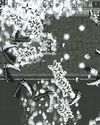
You may well wonder why Madeline wants to climb Celeste Mountain. It’s clear from the moment we meet her that she is no mountaineer; she’s hardly even the outdoorsy type. She arrives at the base of Celeste because she feels conflicted, without quite knowing why or what about. Madeline is snappy and irritable, suffers from panic attacks, and needs to get out of her own head. Her chosen task feels almost masochistic, more like self-punishment for her sense of inadequacy than a healthy challenge. Which raises another question: if Madeline seeks out Celeste because she feels conflicted, what does that say about why we seek out Celeste?
Celeste is a game about coping with anxiety and depression, but also speaks to a deeper sense that we’re never quite aligned with ourselves. There’s always an itch we can never quite reach. It’s an idea that runs to the heart of psychoanalysis, back to Freud himself, and the discontent of repressing our drives for the sake of civilisation. So it’s no surprise if we invent challenges to escape, or in vague hope of finding our complete selves on the way. Celeste provides both. It can be an engrossing distraction, certainly, but its arduous ascent can lead to a kind of self-acceptance – if only we can recognise that our notions of achievement and wholeness may be the obstacles standing in the way.
この記事は Edge の July 2021 版に掲載されています。
7 日間の Magzter GOLD 無料トライアルを開始して、何千もの厳選されたプレミアム ストーリー、9,000 以上の雑誌や新聞にアクセスしてください。
すでに購読者です ? サインイン
この記事は Edge の July 2021 版に掲載されています。
7 日間の Magzter GOLD 無料トライアルを開始して、何千もの厳選されたプレミアム ストーリー、9,000 以上の雑誌や新聞にアクセスしてください。
すでに購読者です? サインイン

BONAPARTE: A MECHANIZED REVOLUTION
No sooner have we stepped into the boots of royal guard Bonaparte than we’re faced with a life-altering decision.

TOWERS OF AGHASBA
Watch Towers Of Aghasba in action and it feels vast. Given your activities range from deepwater dives to climbing up cliffs or lumbering beasts, and from nurturing plants or building settlements to pinging arrows at the undead, it’s hard to get a bead on the game’s limits.

THE STONE OF MADNESS
The makers of Blasphemous return to religion and insanity

Vampire Survivors
As Vampire Survivors expanded through early access and then its two first DLCs, it gained arenas, characters and weapons, but the formula remained unchanged.

Devil May Cry
The Resident Evil 4 that never was, and the Soulslike precursor we never saw coming

Dragon Age: The Veilguard
With Dragon Age: The Veilguard, BioWare has made a deeply self-conscious game, visibly inspired by some of the best-loved ideas from Dragon Age and Mass Effect.

SKATE STORY
Hades is a halfpipe

SID MEIER'S CIVILIZATION VII
Firaxis rethinks who makes history, and how it unfolds

FINAL FANTASY VII: REBIRTH
Remaking an iconic game was daunting enough then the developers faced the difficult second entry

THUNDER LOTUS
How Spirit farer's developer tripled in size without tearing itself apart